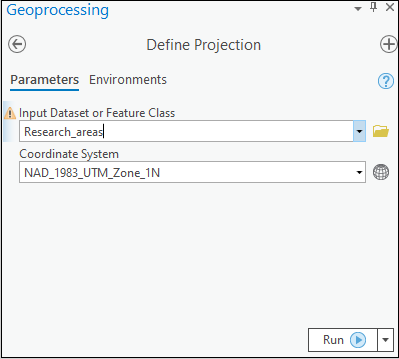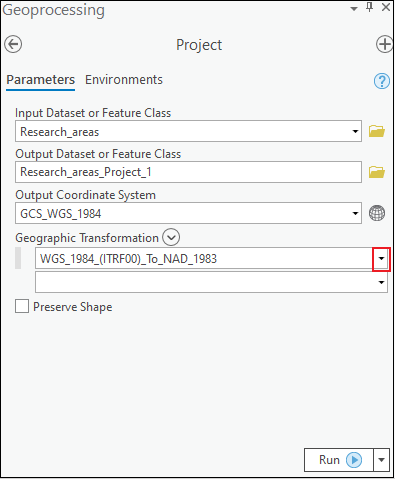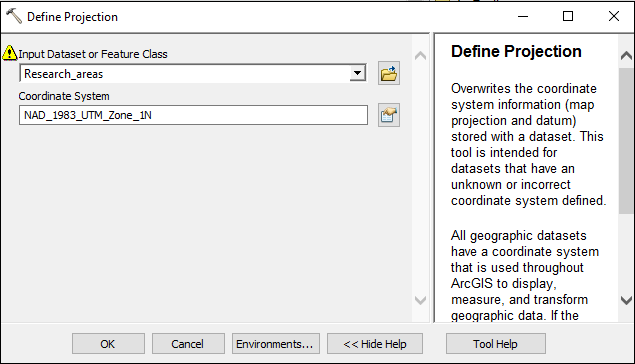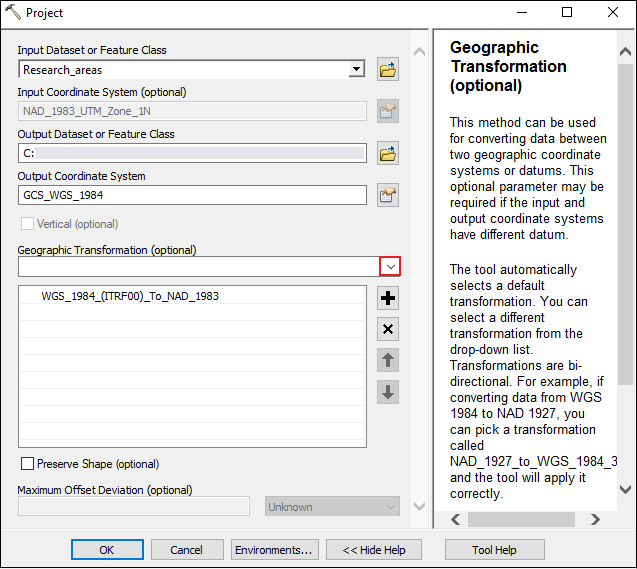PROBLEM
The geographic transformation list in the Project tool is unavailable
Description
In ArcGIS Desktop, either ArcMap or ArcGIS Pro, when attempting to transform geographic coordinate system using the Project tool, the Geographic Transformation drop-down list is blank. Clicking the warning icon in the Geographic Transformation section in the Project tool window returns the following warning message:
"WARNING 001839 A datum transformation is expected, but the parameter is empty."
In ArcGIS Pro

In ArcMap

Cause
The Geographic Transformation drop-down list is generated by the Projection Engine. The issue occurs when the criteria used by the Projection Engine to identify the appropriate geographic transformations and create the drop-down list of the transformations are not met. Refer to: FAQ: How does the Projection Engine list available geographic (datum) transformations, and why is the drop-down sometimes blank? for more information.
This problem can occur due to the following causes:
- The input projection may have been defined in a different software program that does not use the same projection file format employed in Esri software. Esri uses the file format published by the European Petroleum Survey Group (EPSG).
- There are no transformations available between the input and output geographic coordinate systems (GCS).
- The input dataset or feature class has an unsupported or a custom GCS.
Solution or Workaround
To resolve the first issue, define the projection of the data using an available coordinate system in ArcGIS Desktop before transforming the GCS using the Project tool. Complete the steps below to do so:
In ArcGIS Pro
Note: The data projection must be defined using an Esri PRJ file in the coordinate system the data is projected to. If the current projection file is human-readable, open the file in Notepad, and compare the parameters with available projection files for that geographic area provided in Esri software. To identify the coordinate system of the data, refer to: How To: Identify the spatial reference, projection, or coordinate system of data.
- Define the projection of the data using an available coordinate system in ArcGIS Pro.
- On the ArcGIS Pro top ribbon, click the Analysis tab > Tools.
- In the Geoprocessing pane, search for Define Projection (Data Management Tools), and click it. The Define Projection window opens.
- In the Define Projection window, click Parameters.
- For Input Dataset or Feature Class, select the desired data.
- For Coordinate System, select a coordinate system based on the dataset's extent. See: How To: Identify the spatial reference, projection, or coordinate system of data for more information. In this example 'NAD_1983_UTM_Zone_1N' is selected.
- Click Run.

Note: Each transformation is designed for a particular area. For more information on selecting the best transformation and lists of the available transformations, refer to: How To: Select the correct geographic (datum) transformation when projecting between datums
- Transform the geographic coordinate system of the data using the Project tool.
- In the Geoprocessing pane, search for Project (Data Management Tools), and click it. The Project window opens.
- In the Project window, click Parameters.
- For Input Dataset or Feature Class, select the desired data.
- For Output Dataset or Feature Class, specify a name for the output.
- For Output Coordinate System, select a new coordinate system for the data. In this example, the selected coordinate system is 'GCS_WGS_1984'.
- In the Geographic Transformation section, click the drop-down arrow next to the suggested transformation to view the geographic transformation list, and select a desired transformation. In this example, 'WGS_1984_(ITRF00)_To_NAD_1983' is selected.
- Click Run. A new output set of data is created in the specified output coordinate system. The input data still exists in the original coordinate system.

Note: The Define Projection tool updates the existing coordinate system information of the data, but it does not modify any geometry. Refer to ArcGIS Blog: Define Projection or Project? for more information on the difference between the Define Projection and Project tools.
In ArcMap
- Define the projection of the data using the projection definition which matches that from the other software program as described above.
- In ArcMap, click the ArcToolbox
 icon. In the ArcToolbox pane, click Data Management Tools > Projections and Transformations > Define Projection.
icon. In the ArcToolbox pane, click Data Management Tools > Projections and Transformations > Define Projection. - In the Define Projection window, select the desired data for Input Dataset or Feature Class.
- For Coordinate System, select a coordinate system based o the original coordinate system from the other software program. In this example, 'NAD_1983_UTM_Zone_1N' is selected.
- Click OK.
- In ArcMap, click the ArcToolbox

- Transform the geographic coordinate system of the data using the Project tool
- In the ArcToolbox pane, click Data Management Tools > Projections and Transformations > Project.
- In the Project window, select the desired data for Input Dataset or Feature Class.
- For Output Dataset or Feature Class, specify the folder location and name for the output.
- For Output Coordinate System, select a new coordinate system for the data. In this example, the selected coordinate system is 'GCS_WGS_1984'.
- Under the Geographic Transformation (optional) section, click the drop-down arrow to view the geographic transformation list, and select a desired transformation. In this example, 'WGS_1984_(ITRF00)_To_NAD_1983' is selected.
- Click OK. A new output set of data will be created in the specified output coordinate system. The input data still exists in the original coordinate system.

To address the second cause listed above, that there may be no supported transformation between the desired input and output GCS, the first step is to investigate any transformations that have been calculated between the two geographic coordinate systems. Custom transformations can be added to the software following the instructions in: How To: Create a custom transformation between South American Datum 1969 and SIRGAS 2000. This example can be followed for other transformations for different areas.
To address the third cause listed above, that the input data has a custom or unsupported GCS, a custom geographic coordinate system can be created in ArcGIS Desktop products. If a transformation has been calculated between the custom geographic coordinate system and some standard GCS has been calculated that can also be added to the software.
For assistance with above two topics, please contact Esri Technical Support.
Article ID: 000024600
- ArcMap
- ArcGIS Pro 2 7 x
- ArcGIS Pro 2 x
Get help from ArcGIS experts
Start chatting now

